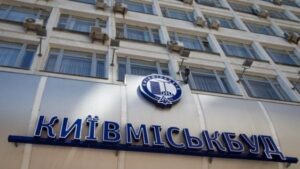
Ukrainian boxer Oleksandr Usyk tops the updated ranking of the world’s top 10 boxers published by The Ring.
It is noted that Usyk last entered the ring in July 2025, winning by knockout in the fifth round against Britain’s Daniel Dubois and becoming the undisputed world heavyweight champion. Later, in November, Usyk voluntarily vacated the WBO belt.
In the updated rankings, Usyk rose from second place to first after American Terence Crawford ended his career. In general, all boxers in the rankings moved up one position, while American Oscar Collazo, the WBA and WBO world champion in the minimumweight division, entered the top 10.
Thus, the top three boxers in the world are Ukrainian Oleksandr Usyk, who competes in the heavyweight division, Japanese Naoya Inoue, who competes in the featherweight division, and American Jesse Rodriguez, who competes in the lightweight division.

PJSC HC Kyivmiskbud received additional capitalization in the amount of UAH 2.56 billion and renewed its management team, according to the company’s press service.
As noted in the release, thanks to the support of the Kyiv City Council, the Kyiv City State Administration, and the mayor of Kyiv, PJSC HC Kyivmiskbud received additional capitalization in the amount of UAH 2.56 billion and is moving on to the next stage of its anti-crisis plan. In particular, the supervisory board has been strengthened, with Petro Panteleev, acting first deputy head of the Kyiv City State Administration, appointed as its new chairman.
The supervisory board also decided to change the company’s management board. Valery Zasutsky, a professional builder and member of the National Association of Builders of Ukraine, has been appointed as the new chairman of the management board.
“These steps are necessary for the further implementation of the company’s anti-crisis plan in 2026, in particular, to stabilize the company’s financial condition; establish more transparent communication and productive cooperation with investors; and gradually resume construction on the company’s facilities.
Communication with the government has also been strengthened to resolve the issue of compensating Kyivmiskbud PJSC with UAH 2.28 billion for the Ukrbud facilities transferred to the company,” the release said.

According to the Serbian Economist, Croatia is officially reintroducing compulsory military service on January 1, 2026 after a 17-year hiatus.
According to changes to the Defense Law approved by the Croatian Parliament in October 2025, the country is introducing two months of basic military training for conscripts amid rising tensions in Europe and the Balkans.
According to Ministry of Defense clarifications and government communications, the mandatory service will apply to men, primarily young men born in 2007 and onward, while women will be able to participate on a voluntary basis. The first calls for medical examinations are scheduled to be sent out at the end of December, while the first conscripts will enter military units in March 2026.
Basic service (temeljno vojno osposobljavanje) will last two months and include handling personal weapons, use of modern equipment, first aid and basic self-defense skills.
Recruits will receive about 1,100 euros per month (2,200 euros for the entire term of service), with payment for food, accommodation and travel; the time of service will be counted in the employment record. For conscientious objectors, civilian service in the civil protection system for up to three or four months with a lower payment (about 250 euros per month) is envisaged.
Previously, compulsory conscription in Croatia was abolished in 2008 amid the transition to a professional army and NATO membership. The authorities explain the decision to return military service by the need to strengthen defense capabilities and prepare the population to act in crisis situations against the backdrop of Russia’s war against Ukraine and the general growth of instability in the region.
https://t.me/relocationrs/2005

Developer Perfect Group has commissioned more than 60 thousand square meters of housing in 2025, the press service of the company told the agency “Interfax-Ukraine”.
“In 2025 we actively worked on a number of Residential Complexes within the consolidated portfolio: we completed Residential Complex ”7 KVARTAL“ house 7.2, Residential Complex ”Swan Guest House“ and put into operation lines in Residential Complex ”Likograd”. We are actively working on projects, among which are apart-hotel “VELMY”, Residential Complex ‘Stanford’ and Club House “LA MANCHE”, – said the head of Perfect Group projects Alexey Koval.
In particular, according to his data, the total area of the commissioned house in “7 KVARTAL” is 21 thousand 605,0 sq. m., there are 288 apartments with the area of 16 thousand 18,4 sq. m. in it. Residential Complex “Likograd” total area is 31 thousand 691,9 sq. m., the area of 384 apartments is 25 thousand 199,5 sq. m. LCD “Swan Guest House” – total area of 8 thousand 264.5 sq. m., 163 apartments totaling 7 thousand 889.4 sq. m.
“The peculiarity of the year – realization in conditions of increased requirements to safety and autonomy of houses, therefore a part of technical solutions were specified already in the process of construction”, – Koval emphasized.
According to him, among the practical changes that have become “the new norm”: strengthening of engineering solutions for the operation of the house during power outages (backup power supply of critical systems, optimization of ITP/pumping equipment), additional fire safety measures and for the organization of evacuation, as well as a more systematic approach to barrier-freeness in common areas (entrances without thresholds, convenient routes to elevators, width of passageways, navigation).
“Some of the solutions were refined to take into account the availability of materials/logistics and the safety situation, but the overall concept of project quality was retained,” he says.
Next year, the company expects a cautious increase in market activity, provided the safety situation is relatively stable and demand financing tools are maintained/expanded.
“Our focus is on projects with proven liquidity, phased queues and clear economics. We are planning to fully complete the 7 KVARTAL Residential Complex, bring the LA MANCHE Residential Complex to the final stage, and introduce the first stages of the Standford Residential Complex. From new projects – LCD “New Tone”, – said Koval.
As for prices, he believes, their cost price will be primarily influenced by the wage factor. “We have already faced a catastrophic shortage of labor in the Ukrainian market. We are actively working on labor contracts with foreigners for contract work, including the search for workers in India and a number of other countries,” Koval said.
In addition, the project manager added, the cost of production is pressured by the cost of energy, logistics and import-dependent positions. A separate item is the tightening of requirements for engineering systems and security.
“Our base scenario is cost of production growth within 15-20% y/y, but the range will depend on the exchange rate, material prices and the situation on the labor market. We are building in a margin of safety through longer contracts with contractors, optimizing design solutions without sacrificing quality and planning critical material purchases ahead,” said Kowal.
Founded in 1991, Perfect Group has delivered 45 homes since 2010, with 18 homes under construction.

On December, 23rd Kharkivoblenergo JSC announced about the intention to conclude with IC VUSO (Kiev) the contract for the purchase of services of compulsory insurance of civil liability of owners of land vehicles (OSAGO).
According to the message in the system of electronic public procurement Prozorro, the price offer of the company – the only participant of the tender corresponded to the expected cost of purchasing services of UAH 423.5 thousand.
IC “VUSO” was founded in 2001. It is a member of ITSBU and NASU, a participant of the Agreement on direct settlement of losses and a member of the Nuclear Insurance Pool.
INSURANCE, Kharkovoblenergo, Motor transport, MTPL insurance, VUSO

Nova Poshta, the leader in express delivery in Ukraine and part of the Nova Group, processed 2.41 million shipments in a single day on December 22, exceeding the previous record of 2.25 million set on December 23, 2024, by 7.1%, the company announced on Friday.
“This is a joint record for the company and our customers, in particular entrepreneurs whose goods we delivered and who, despite all the challenges and difficult conditions, continue to work and support our country’s economy,” said Volodymyr Poperechnyuk, co-owner of Nova Poshta, in a press release on Friday.
It is noted that in 2023, the record day was December 18, when the company processed 2.01 million parcels throughout Ukraine.
The company added that on peak days in December, more than 1,000 additional colleagues from the office were involved in processing parcels.
“Nova Poshta has a pre-New Year tradition when support office employees join the work in branches, at terminals, in fulfillment, as couriers, and as contact center operators,” the company said.
Nova Poshta previously reported that in the first half of 2025, it delivered 238 million parcels and cargoes, which is 7% more than in the same period in 2024, as well as 5.9 million international parcels.
As of October 6, the leader in express delivery in Ukraine had 44,983 service points, including 14,336 branches and 30,647 parcel terminals. In the first half of this year, the branch network grew by 708 points to 13,985, and the number of parcel terminals increased by more than 4,000 to 28,326.
Nova Poshta’s consolidated net profit for January-September 2025 increased by 35.1% compared to the same period last year, to UAH 2 billion 876.38 million, consolidated net income – by 21.7%, to UAH 45 billion 727.67 million.
The main activity of Nova Poshta is express delivery of documents, parcels, and palletized large-sized cargo.